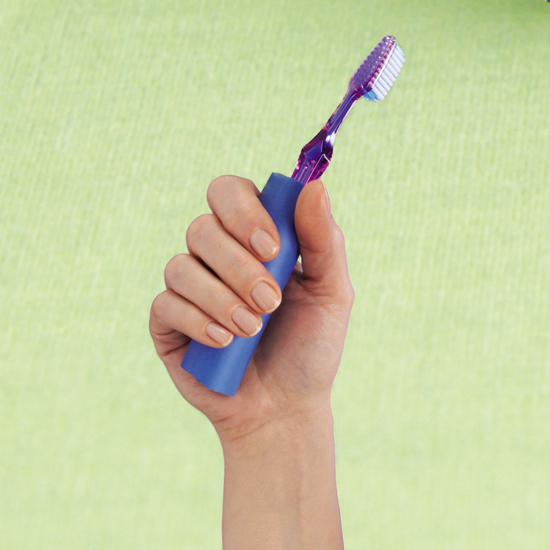
Independence issues
If you’re like many people, independence is the bedrock upon which you’ve built your life. More than virtually anything else, you treasure your freedom from the control of others — the opportunity to act according to your will and to make decisions for yourself as you see fit.
Your later years, however, can present a significant challenge to the self-reliance that you’ve enjoyed from young adulthood onward. As the years go by, your body and mind may change in ways that can affect both your safety and security.
Perhaps you’re not at the point in your life in which you need to be concerned about these issues yet. But you may be caring for older parents and you’re confronted with aspects of independence from the opposite side. The information here can help you make suggestions or decisions regarding their care and daily living.
Fortunately, options for ensuring independence grow more numerous every day. Whole industries have evolved to give older adults additional choices in their lives, while decreasing infringements on their independence. And increasing technology allows them to interact with the world like never before, opening up numerous new opportunities for information, communication and growth.
In this chapter, we explore many of the tools and resources that can help older adults retain their valuable independence and “live smarter” in their golden years.
You may have heard the phrase “Work smarter, not harder.” If you swap live for work, you’ll begin to understand the idea behind assistive devices.
These tools can help you with every-day tasks, such as writing a check or buttoning your shirt. Some are simple handle extensions that provide more leverage, while others are specially designed devices backed by high-tech engineering.
Now, you might be thinking that the use of assistive devices really signals old age, and you’d like to stay away from them for as long as possible. But before you relegate assistive devices to forms of weakness or physical surrender, consider how many of them you already rely on to make your life easier and more enjoyable.
For example, it’s unlikely that you hesitate before climbing into an automobile for that short drive to the grocery store. A car is an assistive device. The vehicle helps you to accomplish your goal: getting from point A to point B with greater speed and comfort.
All assistive devices play that same role, to one degree or another. Whether it’s something you do every day, such as reaching down to pick up the newspaper, or something you do less often, such as moving heavy objects around the garden, these aids can help.
Medical supply stores, websites, catalogs, your hospital’s physical therapy department and even your local hardware store are full of specifically designed items and materials that can help you with daily tasks. By using these tools, you can ease pain, add comfort, increase safety, bolster confidence, enhance ability and sustain your independence.
Daily needs devices
Assistive devices are most often used to accomplish simple daily tasks. Using the right tool can facilitate almost everything you need or want to do at home.
In the bathroom, one of the most dangerous rooms in the home, there are a number of options to help you move around safely and reduce strain on your wrists and back. Examples include folding shower seats, grab bars, elevated toilet seats, adjustable shower heads and single-lever faucets. You can also buy long-handled brushes, combs and sponges so that you don’t have to reach over or behind your head as much. Several manufacturers now make toothbrushes and hand mirrors with foam rubber grips for an easier grasp.
In the kitchen, a wheeled cart can help you transport many items at once, which saves time and energy. Electric can openers do all the maneuvering for you, and many can be installed under a kitchen cabinet for easy access. Look for vegetable peelers, ladles, knives and other utensils with larger, preferably rubberized, grips. Holding on to something that has a large handle eases the strain on your hand and wrist; the rubber will help maintain your grip.
On your chairs and sofas, try some extra cushioning. Seating that’s higher and firmer is easier to get out of than is seating that’s lower and softer. To make it easier to slide in and out of your car, place a silky pillowcase or brown paper bag on your car seat.
And don’t forget one of the greatest tools of all — proper lighting. Use the highest wattage bulbs allowed on your light fixtures to illuminate work and leisure areas.
~ ~ ~ ~ ~ ~ ~ ~ ~ ~
Common daily assistive devices
A foam tube that slides onto objects such as a toothbrush can make them easier to grip
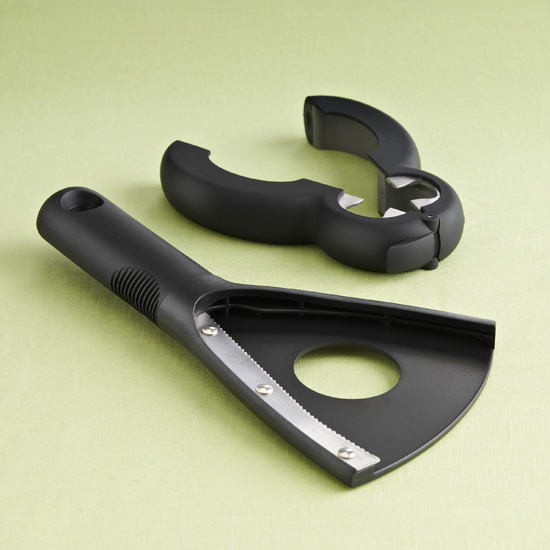
Different types of opening devices can make a stubborn jar lid or bottle cap easier to tackle
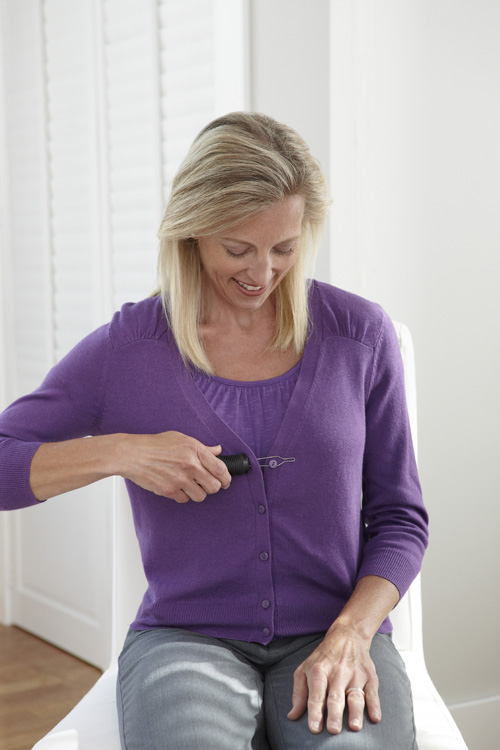
A buttonhook can help you grasp and fasten buttons on your clothes
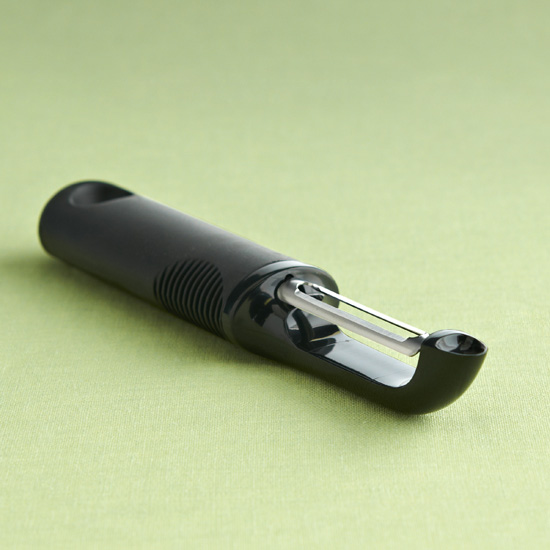
Many kitchen tools, such as vegetable peelers, can be purchased with larger handles
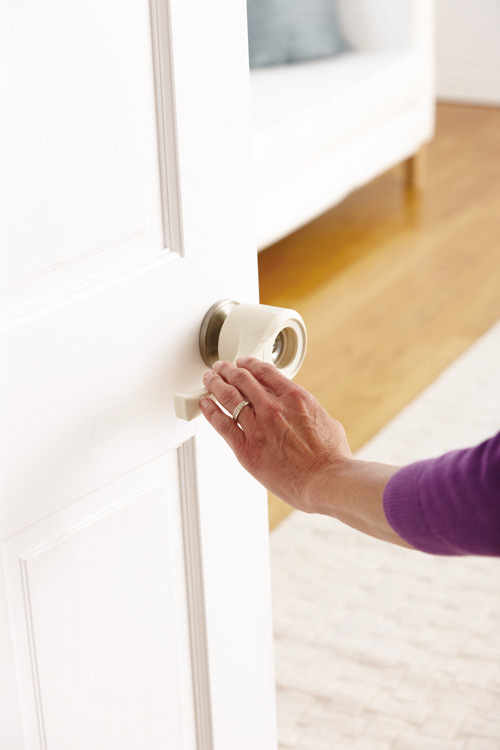
A lever attachment makes it easier to work a doorknob
~ ~ ~ ~ ~ ~ ~ ~ ~ ~
Health and fitness devices
Mountaineers often use ski poles while hiking through rough terrain. You can do the same for a walk around your neighborhood. Stationary bicycles, stair steppers and treadmills make great assistive additions to any home gym. They give you better stability and a way to regulate your workout routines. If you have access to a swimming pool, look at the variety of flotation equipment that water-trained runners and water aerobics enthusiasts commonly use.
For working in the garden, look for tools with wider handles and a better grip. Spring-loaded clippers and pruners eliminate the need to open the tools and reduce the pressure needed to close them. Rakes, hoes and other tools with long handles let you do your work with less bending.
Electronic devices
Yes, they can often seem intimidating. But the wide variety of electronic “gadgets” on the market aren’t just for the young. These devices can open up a new world of convenience and opportunity if you take the time to learn the basics.
~ ~ ~ ~ ~ ~ ~ ~ ~ ~
When is it time to give up the keys?
You may reach a point when retiring your car keys is in everyone’s best interest. Or, perhaps, you’re worried about a parent who’s still driving. Knowing when to give up — or take away — the keys can be a tough call.
Some signs that it’s time to quit driving are more obvious: being involved in preventable accidents or receiving an increased number of traffic tickets or warnings. But sometimes the signs may be more subtle. Consider giving up the keys if you or someone else notices that you’re consistently:
By understanding your limitations as a driver, you can better prepare for driving or perhaps giving up driving altogether. Listen to your friends and family. If they suggest you cut back on your time behind the wheel, they’re only doing it with your best interests in mind. Talk to your doctor about how your health may affect your driving.
You may have family and friends to rely on for occasional rides. Most communities have options available to help you get around, as well. Mass transit services, including city buses and subways, may provide discounted fares to seniors. Senior transit may be available, often in the form of shuttle services. Taxis and delivery services also can help in a pinch.
~ ~ ~ ~ ~ ~ ~ ~ ~ ~
“Knowledge itself is power,” said Sir Francis Bacon. And, he might have added, power means independence. One of the most useful devices at your disposal is the computer and the access it gives you to the Internet — the most rapidly growing communication medium in history.
If you’ve embraced this technology, good for you. But if you’re resistant to it, you’re missing out on a tool that can bring the world to your door. The Internet can transport you to just about anywhere, from the Smithsonian Institution to your own local library. You can also access almost any news source online.
You can use the Internet to purchase gifts and have them delivered, order groceries, send or receive emails and family photos, do your banking and pay bills, or video chat in real time with a friend or family member who lives across the country. The Internet’s wealth of information and contacts can help you no matter what you want to accomplish, whether it be facing new medical challenges or finding a good plumber. And don’t forget about all the websites mentioned in this book.
If you haven’t ventured into cyberspace yet, consider taking a computer class as a way to get started. Classes are fun, and you can meet people with the same interests.
Along with standard stationary computers, laptops, netbooks and tablets have become increasingly popular in recent years. These devices can perform most of the same tasks as a standard computer with the added convenience of portability.
Basic and ‘smart’ cellphones
More and more older adults are leaping into the cellphone market, drawn by the convenience of being able to make and take calls on the go.
Choose a cellphone that’s comfortable for you. While a device with all the bells and whistles may be all the rage, you may never need all of those features. For example, if you don’t think you’d ever text or access the Internet from your phone — or you don’t wish to pay extra for these services — stick with a “talk” plan with a basic phone instead of a smartphone.
Additionally, there are cellphones designed with aging needs in mind. Some phones come with larger buttons and screens. Some also include an SOS button that can be used to connect with an emergency phone number.
Why would you want to read a book on a screen rather than in paper? There are numerous reasons to enjoy a good, tangible book. But the recent explosion of e-books and e-readers is for good reason, too.
The biggest convenience of an e-reading device is that you can carry multiple books, magazines and newspapers with you within a small, portable device. An e-reader will also save your place and allow you to highlight any passages you’d like to remember.
Older adults especially may discover advantages of e-readers. They tend to be lighter weight and easier to hold than traditional books. Most e-readers also have features that allow you to adjust the book to your needs, such as changing to a larger type-size or turning on audio capabilities.
Many public libraries offer classes on using e-readers, as well as a wide selection of e-books to check out.
Navigation devices
Driving around in unfamiliar territory can be a challenge for anyone. But Global Positioning System (GPS) technology can make navigation significantly easier.
GPS navigation devices use satellites to pinpoint your location and the destination that you enter. They can then provide you maps and step-by-step driving instructions. Some devices also provide traffic and road construction updates, giving you a better idea of what to expect on the road ahead.
Movement and mobility devices
A cane or walker can dramatically extend or increase your independence. Although these devices may seem awkward and hard to use at first, they can help you get around on your own without relying on someone else for help.
Awkwardness with any device is natural. Remember the first time you tried riding a bike or casting a fishing rod? Ease will come with practice.
Walking aids come in a variety of sizes, weights and designs, so it’s best to have a health care professional recommend one that would be most appropriate for you. Ask the same person to help you determine the proper size and fit, as well as the best ways to use it.
It’s a common mistake, for example, to choose a cane that’s too long. The extra length pushes up one arm and shoulder, causing strain to those muscles and your back. The candy-cane-style cane (with a hooked handle) probably won’t be the most comfortable if you use a cane daily. Instead, one with a swan-neck handle will put your weight directly over the cane’s shaft.
Another mobility aid you may wish to look into is a mobility scooter. If you live in an urban setting and are close to a grocery store, for example, a scooter can help you make the trip there and back with minimal effort and allow you to bring your purchases back home with you.
Technology also offers a wide variety of assistive devices to make driving easier. For example, hand controls can be mounted on a steering column. Wheelchair loaders and van lifts improve access. The cost of more advanced equipment can be high, but the mobility it provides may make the expense worthwhile. You may also be able to get financial help from Medicare or Medicaid for certain assistive devices.
~ ~ ~ ~ ~ ~ ~ ~ ~ ~
Generally, choosing a grip is a matter of personal preference. Consider a foam grip or a grip that’s shaped to fit your hand.
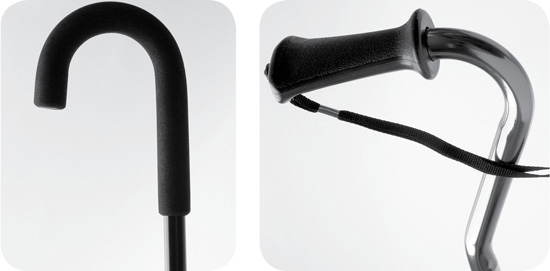
The candy-cane-style cane (left) and swan-neck handle (right) are common choices. But other styles also are available.
To make sure your cane fits you properly:
If you use a cane for stability, you may grip it in either hand — whichever feels the most comfortable. Pick up and move your cane in unison with the opposite leg. Don’t place your cane too far ahead of you. If you have an injury or disability affecting your hip, knee or ankle, your doctor or physical therapist might recommend a specific walking pattern.
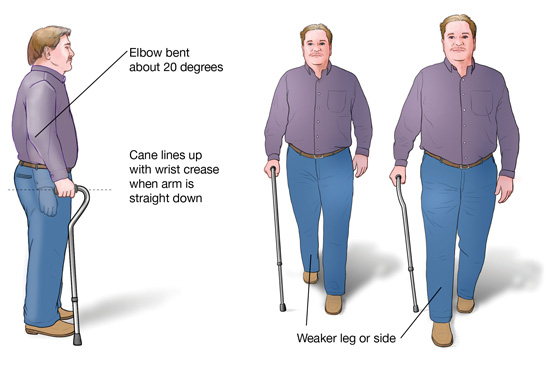
~ ~ ~ ~ ~ ~ ~ ~ ~ ~
Keeping an open mind
Assistive devices can’t do all things for all people. But your attitude toward them is just as important as the devices themselves. If you look at assistive devices as anchors that will drag you down the path of frailty and disability, you may fulfill your own prophecies. But if you view them as tools that enable you to exercise your independence and personal freedom, they can prove very useful in helping you overcome physical limitations.
Housing options
It’s no surprise that, according to an AARP survey, more than 80 percent of older Americans prefer to live and die in their own homes. Most people fear that someday they’ll be helplessly trapped in a nursing home, but U.S. Census Bureau and other national survey figures show that less than 5 percent of Americans older than age 65 live in these facilities. By contrast, more than 90 percent of older adults between the ages of 65 and 84 live in traditional residential homes.
Staying in your present dwelling is just one of many housing options. Broadly speaking, your choices will fall under four categories: independent living, shared living, shared assisted living and fully supported living arrangements.
Ultimately, where you live and how much support you choose will depend on your physical and mental conditions, personal preferences, interests, financial resources, family and your willingness to adapt to change.
Independent living
Your home is the place you feel most comfortable, safe and secure. Maybe you’ve already paid off your mortgage, so except for taxes and maintenance you’re virtually home-free. Perhaps you’ve rented an apartment for years, but it’s home and you really can’t see moving out of the city.
At the same time, however, take an objective look at your present residence to be sure it makes sense long term. Most homes in the United States are designed for able-bodied occupants and may not accommodate the needs of someone older than age 65.
For example, will the stairs of your two-story home eventually present a problem? Is the only bathroom on the second floor? Is the laundry in the basement? Does the big backyard still hold some appeal, or is the upkeep becoming more of a burden? Major repairs may also become more common as plumbing and heating systems age and wear out.
Home modification
If you really want to stay in your home, you may need to make some modifications to make it more convenient and accessible. Whether it’s replacing doorknobs with more easily operated lever handles, installing grab bars in the bathroom or lowering countertops for better access, well-thought-out remodeling plans can build new life into your home.
Research suggests that 30 to 50 percent of home accidents can be prevented through home modification and repair.
Moving to a different home
A cold, hard look at your house might convince you that it’s time to move while you’re still in good physical condition. Maybe a single-story ranch makes more sense or maybe all you really need is a two-bedroom home. Downscaling could also ease your expenses. Standard apartments, condominiums and townhouses can provide the living space you need without the worries of exterior upkeep. Nearby neighbors can offer both social and safety advantages as well.
Retirement communities
Retirement communities provide a variety of options for independence. Often, they’re multi-unit complexes of condos, townhouses or apartments.
One of the major benefits of a retirement community is reduced hassles of home ownership. Such a facility also draws like-minded older adults together and delivers the community services that residents most want and need.
Continuing care retirement communities go even further. These facilities offer multiple services on an a la carte basis so that as residents’ needs change, they can receive additional care within the same setting. A retirement community may provide the independent living setting that you want now and the assisted living setting you may need in the future.
Shared living
Despite the freedom it offers, living alone isn’t for everyone. You can gain some real advantages, both for your emotional well-being and your physical safety, by sharing your residence, moving in with another person or family, or finding a group of like-minded individuals to share living arrangements with.
~ ~ ~ ~ ~ ~ ~ ~ ~ ~
Resources for independent living
Part of living independently means recognizing limitations that present themselves and seeking help in managing them. Numerous resources exist that can help you continue to live independently and stay productive for many years to come.
A great place to start searching for resources in your area is the Eldercare Locator, provided by the U.S. Administration on Aging. You can access this information at www.eldercare.gov or by calling 800-677-1116.
~ ~ ~ ~ ~ ~ ~ ~ ~ ~
House sharing
Sharing your home with one or more people or joining someone else in his or her home can be a joy, a disaster or something in between. Consider any arrangement on a trial basis to start and have open discussions beforehand about issues such as rent, cooking, cleaning, repairs and maintenance, and personal space.
Family connections
Moving in with family used to be the way most older adults transitioned out of their own homes. But with today’s far-flung families, that’s not always an option.
If you want to live with your children or they’re urging you to move in with them, have frank discussions about each other’s expectations. Consider everything from spousal relationships and finances to living space allocations and child care before you start unpacking.
Cohousing
Unrelated people often enjoy the advantages of living as a family unit. Organizations throughout the country offer a collection of privately or cooperatively owned small-group residences.
These arrangements usually include a live-in manager and at least some staff, but they’re primarily for residents in at least relatively good health.
Senior housing
The federal government and most states have programs that help pay for housing for older adults with minimal income and assets. Rent is based on a percentage of your income. Usually, you live in your own apartment in a multiunit housing development.
Some programs also offer help with meals, housekeeping, shopping and laundry. The federal government also offers housing vouchers that allow qualified individuals to lease or purchase a house or apartment.
Shared assisted living
If you need some assistance with bathing, dressing, meal preparation and housekeeping, then assisted living could be a valid alternative to hiring private help in your own home.
Continuing care retirement communities, board-and-care homes, retirement centers, congregate housing and senior residential housing all offer varying levels of support staff, depending on the operator and the needs of their residents.
These assisted living centers usually offer a menu of options, allowing you to tailor your services and costs to your specific needs. Facilities that provide fewer services usually allow outside specialists to give you private help if you need it.
Many assisted living arrangements charge a monthly rental fee for an apartment with utilities, meals, housekeeping, laundry and an emergency call system provided. Additional services generally include extra fees.
These supervised living arrangements work well for residents who have moderate functional impairment. Condition-specific facilities, such as Alzheimer’s centers, also have opened. None of these replaces nursing homes, which offer fully supported care, but they are a reasonable alternative for people who require some degree of assistance with daily living.
Fully supported living
As more living options become available for older adults, nursing home use is declining. These days, nursing homes — now often referred to as skilled nursing facilities — are most suited for rehabilitative care and care in which 24-hour services are required.
For many people, a stay in a nursing home is temporary while they recover from a hip fracture or some other mishap. Once rehabilitated, the individual is often able to return to independent living. This type of arrangement is often referred to as temporary rehabilitation or skilled nursing home care. Other people enter a nursing home because they need full care for a condition that may not improve.
The average nursing home resident has several chronic illnesses that require medical attention. More than half have Alzheimer’s disease or some other mental impairment.
When independent living, assisted living or care by family members isn’t feasible or threatens to destroy the fabric of a family, a nursing home should be considered. If you’re physically able to visit prospective nursing homes and psychologically fit enough to help make the decision, you should participate in the selection process.
In terms of your independence, you would undoubtedly experience some feelings of compromise should you eventually need to move to a fully supported care facility. But you still have the power to choose how you think about those challenges and how they shape your outlook on life.